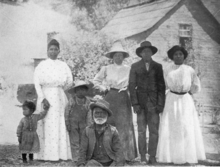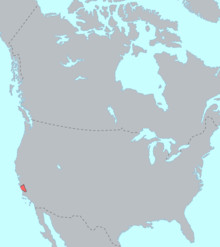Salinan
The Salinan are a Native American tribe whose ancestral territory is in the southern Salinas Valley and the Santa Lucia Range in the Central Coast of California. Today, the Salinan governments are now working toward federal tribal recognition from the Bureau of Indian Affairs.

Te'po'ta'ahl | |
|---|---|
 Miguelino family near Mission San Antonio de Padua | |
| Total population | |
| 681 (2000, census) | |
| Regions with significant populations | |
| Languages | |
| Salinan language | |
| Religion | |
| Kuksu (religion), Salinan traditional narratives |

There were two major divisions, the Miguelino in the south, on the upper course of the Salinas River (which flows south to north), and the Antoniano in the north, in the lower part of the Salinas Basin, corresponding to the two missions in the Salinas Valley (Mission San Antonio de Padua and Mission San Miguel Arcángel). There were also a Playano group on the Pacific Coast in the vicinity of what is now San Simeon and Lucia. Before European contact, Salinans lived by hunting and gathering and, like most other California tribes, were organized in small groups with little centralized political structure.
Etymology
The Salinan people were named after the Salinas River by Robert Latham (needs documentation)(1856) and John Powell (1891). The people's own name for themselves is the "Te'po'ta'ahl" or "People of the Oaks," according to current tribal leadership.[1] C. Hart Merriam called these people the En-'ne-sen on advice from one informant; En-'ne-sen was the native word for the Salinan headquarters.[2]
Language
The Salinan language, spoken until the 1950s[3] is a language isolate. It may be a part of the Hokan language family. Sapir included it in a subfamily of Hokan, along with Chumash and Seri; this classification has found its way into more recent encyclopedias and presentations of language families, but serious supporting evidence has never been presented.[4]
Population
Estimates for the pre-contact populations of most native groups in California have varied substantially. Alfred L. Kroeber put the 1770 population of the Salinan as 3,000.[5] Sherburne F. Cook similarly estimated that there were at least 700 Salinans.[6] The 2000 United States Census reported a total population of Salinan 681.[7]
See also
Notes
- Eargle, Dolan H. , Jr (5 January 2007). Dodsworth, Fred (ed.). "Native California: An Introductory Guide to the Original Peoples from Earliest to Modern Times". Trees Co Pr. Retrieved 13 October 2017.
- Hester, p.504
- "Salinan Language and the Salinan Indian Tribe (Sextapay, Antoniano, Migueleno)". Native-languages.org. Retrieved 13 October 2017.
- Marlett 2008
- Kroeber, p.883
- Cook, p.187
- "Census 2000 PHC-T-18. American Indian and Alaska Native Tribes in the United States: 2000" (PDF). September 2002.
References
- Campbell, Lyle (1997). American Indian languages: the historical linguistics of Native America. Oxford: Oxford University Press.
- Cook, Sherburne F. 1976. The Conflict between the California Indian and White Civilization. Berkeley, California: University of California Press.
- Kroeber, Alfred L. 1925. Handbook of the Indians of California. Bureau of American Ethnology Bulletin No. 78. Washington, D.C.
- Hester, Thomas R. 1978. Salinan, in Handbook of North American Indians, vol. 8 (California). William C. Sturtevant, and Robert F. Heizer, eds. Washington, DC: Smithsonian Institution, 1978. ISBN 0-16-004578-9 / 0160045754, pages 500-504.
- Marlett, Stephen A. 2008. The Seri-Salinan connection revisited. International Journal of American Linguistics 74.3:393-399.
- Sapir, Edward. 1925. The Hokan affinity of Subtiaba in Nicaragua. American Anthropologist 27: (3).402-34, (4).491-527.
- National Public Radio segment by Allison Herrera, December 13, 2017